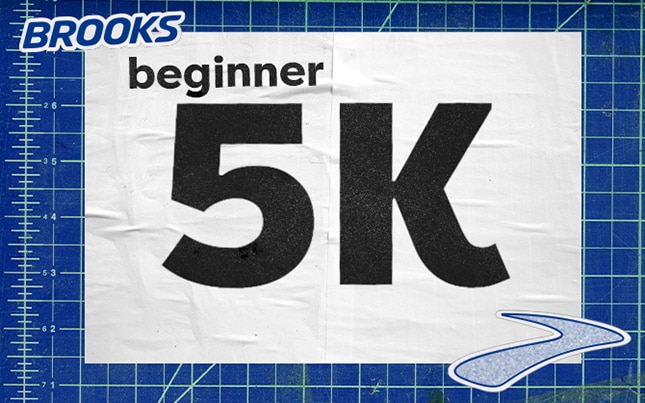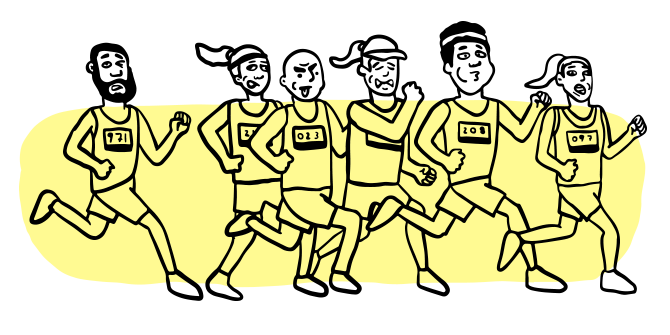Running a 5K: Beginner training plan

Looking for a motivation boost? A new running goal? An excuse to do some A+ carb loading? Consider signing up for a 5K. Our guide walks you through how to prep for running a 5K race.
What is a 5K?
If you’re new to racing, your first question may be “how much is a 5K?”
The term is shorthand for “five kilometres”, which is just over three miles.
5 KM average running time
The average running time for a 5KM run is 30 to 40 minutes, making it fast, fun, and far less intimidating than races that span well over an hour. It’s easy to see why this is the most popular race distance in the USA year after year.
5K running tips to train and prepare
OK, so the race is just a couple miles long and enough people will be in the pack to hide any weird running faces you make. Sound good? Here are some 5K running tips to get started.

Training for any race requires a holistic approach. You’ll need the right gear, good nutrition, a well-planned schedule, and accountability to keep yourself on track.
The first tip for running a 5K is to look at gear (not-so-secretly our favourite topic) before you do anything else. Make sure you have shoes, bras and running clothes that will hold up not just for the race but for all the miles you’re going to put into training beforehand. It's also good to know when to replace your running shoes. Find reliably comfortable pieces and plan your race-day outfit in advance so you can take it for a test run. Don’t wear anything new on the day you are running the 5K — the road to the finish line is paved with rashes, blisters and chafing in unspeakable places from previously untested gear.
Then some nutrition tips for running a 5K. Many runners find it helpful to experiment with their diets in the weeks leading up to a race. What you eat before running a 5K is important. Use your training period to figure out how to avoid GI distress on the run and pinpoint what gives you energy to perform your best.

Don’t forget that decisions you make off the run affect your miles: eat a balanced diet, get enough sleep, and hydrate properly. Get in the habit of drinking water not just when you run but throughout your training.
Finally, you’re going to need a plan. More advanced runners may want a different strategy, e.g. if you’re looking to improve on an old time, you’ll likely need to do some speed work. But if you’re ramping up to your first start line, here’s a schedule to get you to your mark.
How to breathe while running a 5K
Headed out for a run and found it difficult to catch your breath? You’re not alone. Running causes your muscles and respiratory system to work harder than usual, requiring more oxygen, which can make breathing more difficult. If you’re finding 5k breathing particularly difficult, it could be that you’re pushing yourself too hard. Let’s take a look at how to breathe while running a 5k and leave those shallow breaths behind.
If you find that you can’t have a conversation whilst you’re running, try breathing through your mouth instead of your nose. This allows more oxygen to enter your body - and it ensures you can’t clench your jaw, helping your whole body to relax.
You should also try to take deep belly breaths (also known as diaphragmatic breathing) rather than shallow chest breaths. This is one of the best breathing techniques for running 5k, as it strengthens the muscles you use for breathing, allows you to take in more air, and can help to prevent side stitches. If you’ve never tried belly breathing before, it can feel a bit strange at first, so it’s a good idea to practice at home before you start using it on your runs.
To get a feel for it:
- Lie on your back and place your hands on your stomach
- Breathe in and out deeply - you should see your hands rise as you inhale, and fall as you exhale
- Take a deep breath in and fill your belly with air
- As your belly expands, focus on exhaling the air out through your runs
- Over time you can build up so your exhales are longer than your inhales
The ultimate 5K warm up
It’s a good idea to get into the habit of warming up before heading out for a run, no matter what the distance is. Doing a 5k warm up activates your bones, muscles and joints, helping to prevent running injuries. It also raises your heart rate and increases your core temperature, so you should be raring to go once you’ve finished your warm up. What’s more, it gets you into the right headspace for getting those kilometres in. Here’s how to warm up for a 5k, whether you’re racing for a PB or looking for a Couch to 5k warm up.
Start with a short jog of 5 to 10 minutes to get you warmed up and your heart racing. You could also opt for a brisk walk if you don’t want to run too far. Then move on to dynamic stretching, taking your joints and muscles through a range of motions.
Try these exercises in your 5k warm up:
- Forward lunges
- Side lunges
- Forward leg swings
- Heel flicks
- High knees
Couch to 5K printable plan for beginners
With this 5K training plan, in just about two months, you can go from “I only run when chased” to mile master. Seriously. Once your body gets used to running, the sport gets easier and the distance flies by. Here's a couch to 5K plan printable to help you get started.
A lesson in lingo for your 5K training plan
Here’s a guide to some of the terminology in our 5K training plan.
GP: Goal pace. This is the speed you’re hoping to maintain for the race.
Tempo: For our purposes here, your tempo pace is one that’s challenging but sustainable. You’re out of breath but you could maintain your speed for 45 minutes.
Recovery pace: An easy jog, often reserved for active rest between faster intervals.
‘: minutes (3’ is 3 minutes)
“ : seconds (45” is 45 seconds)
Rest: Put your feet up! You need to reserve some days to let your muscles recover.
Cross-train: Do a non-running activity (swim, do yoga, lift weights, etc.)
For more runner vocab — including some of the weirdest words in the sport — check out our glossary.
How to run a faster 5K
Ready to pick up the pace? If you’re wondering how to run a faster 5k, here are some tips to help you achieve your goal:
- First, set a goal. It can help to have something to aim for. Maybe you’re running a 30 minute 5k at the moment - then you could set your goal as 25 minutes. It should be an achievable goal but not overly ambitious, and you could aim to have smashed it in 1, 3, or 6 months.
- Think about gradually improving your time. You’re not going to magically drop 5 minutes from your time in a month, but running a faster 5k by 10 seconds every fortnight? That’s achievable.
- Run faster. If you really want to know the secret of how to improve a 5k running time, this is it. Try interval sessions and hill reps to increase your pace for 30 seconds or a minute at a time, and eventually, those faster paces will feel easier.
Ramp up to race day
Still on the hunt for runspiration? Enlist a training buddy or join a running group — there are online groups to accommodate COVID-19 restrictions. Try out some new gear. Or check out our favourite inspiring stories.
Once you've mastered running a 5K, you can step up your game and start the 10K running plan.
